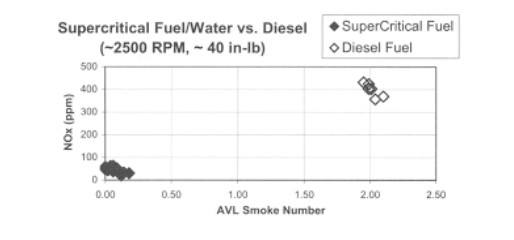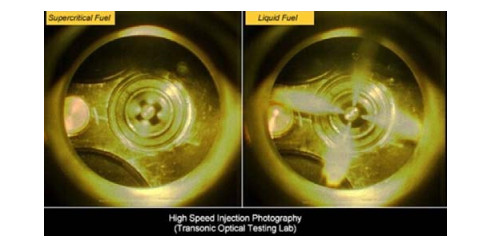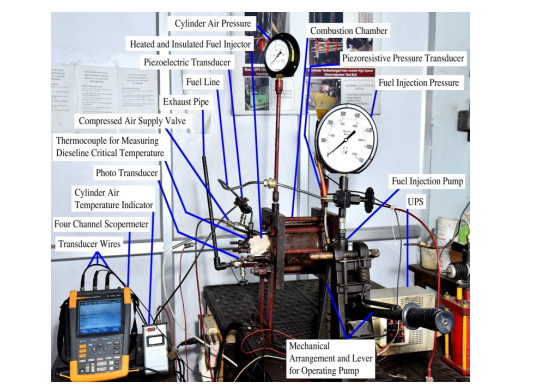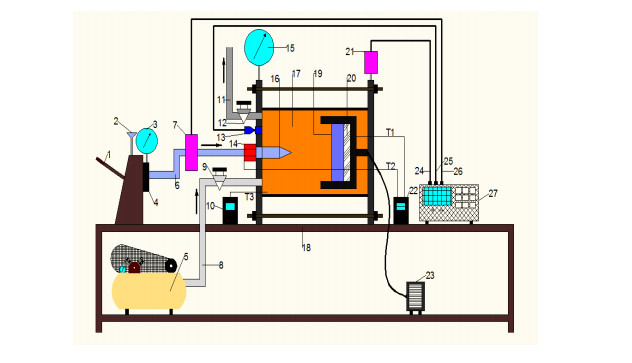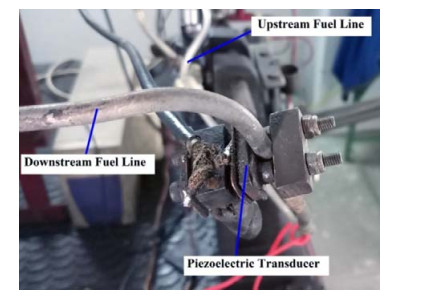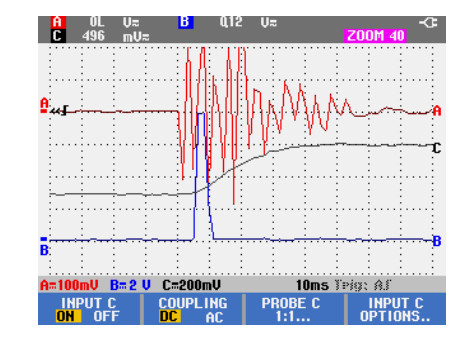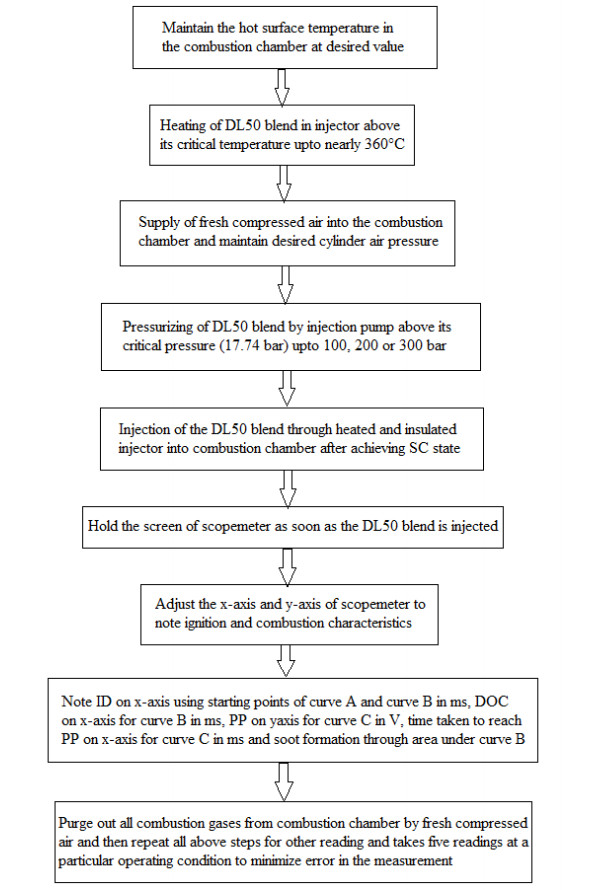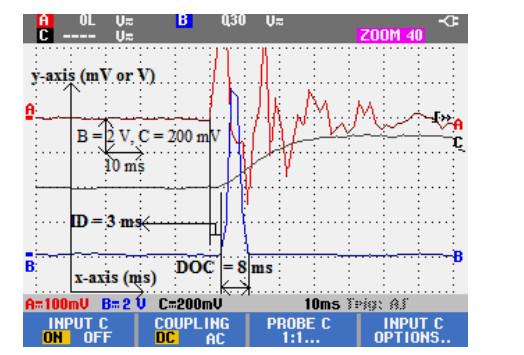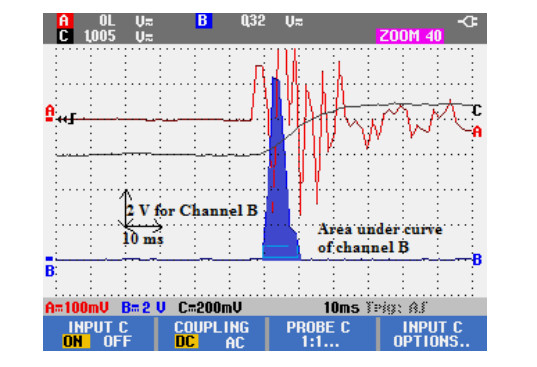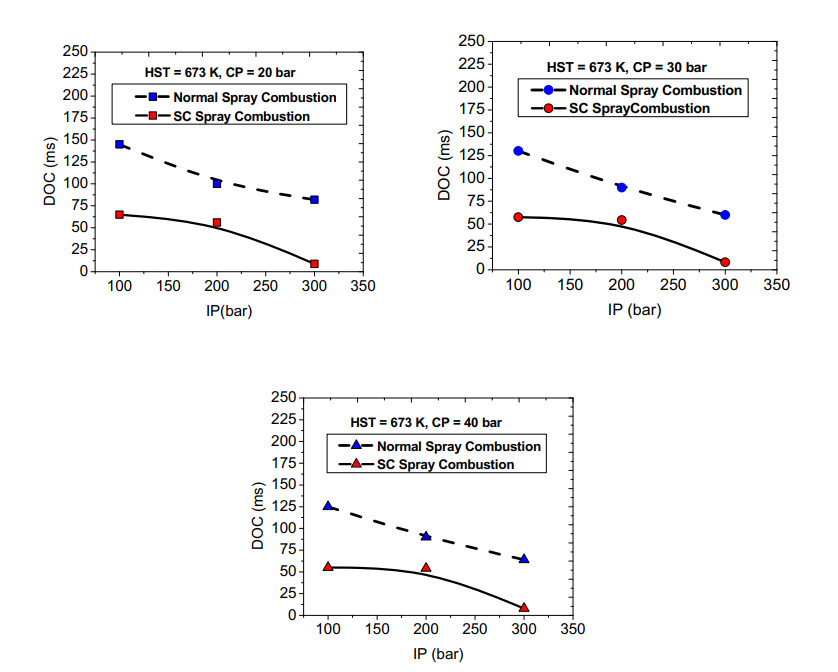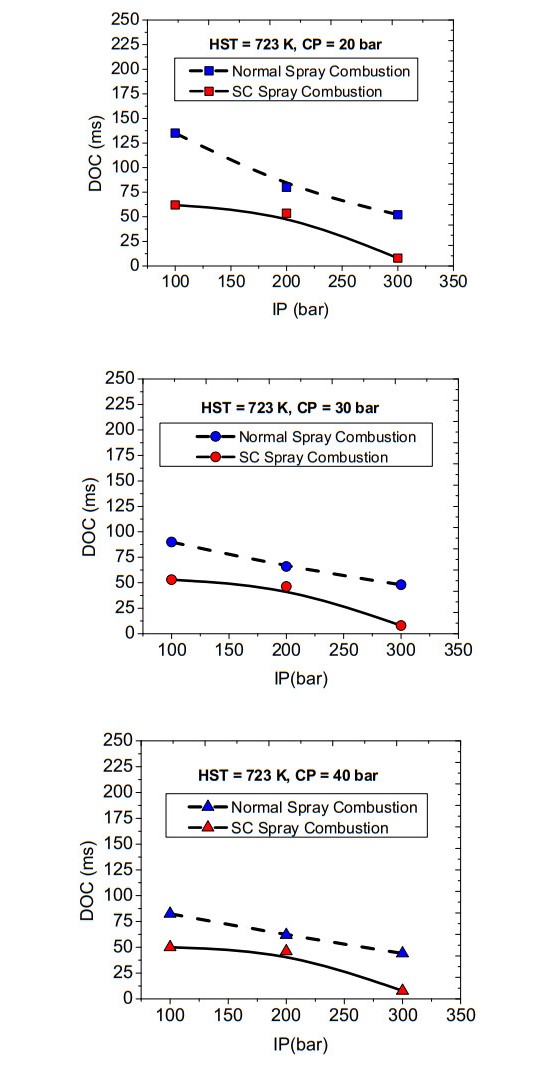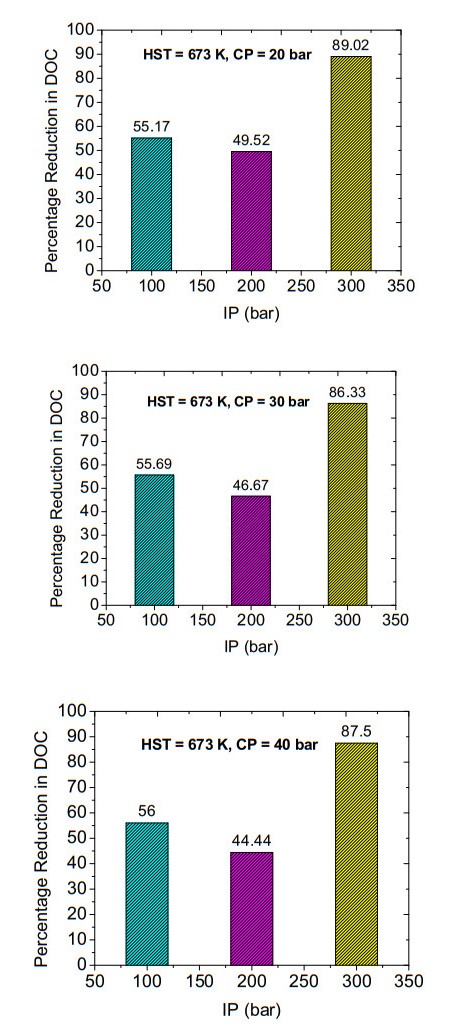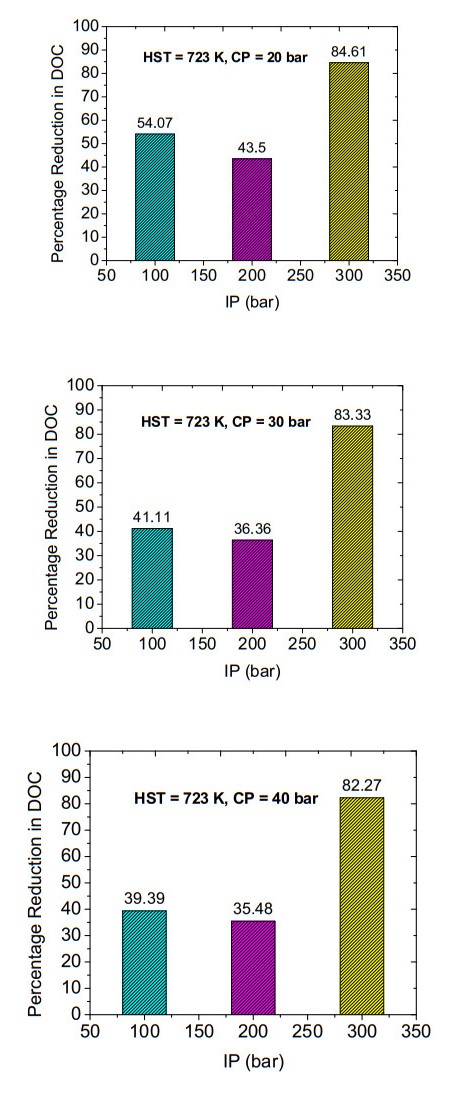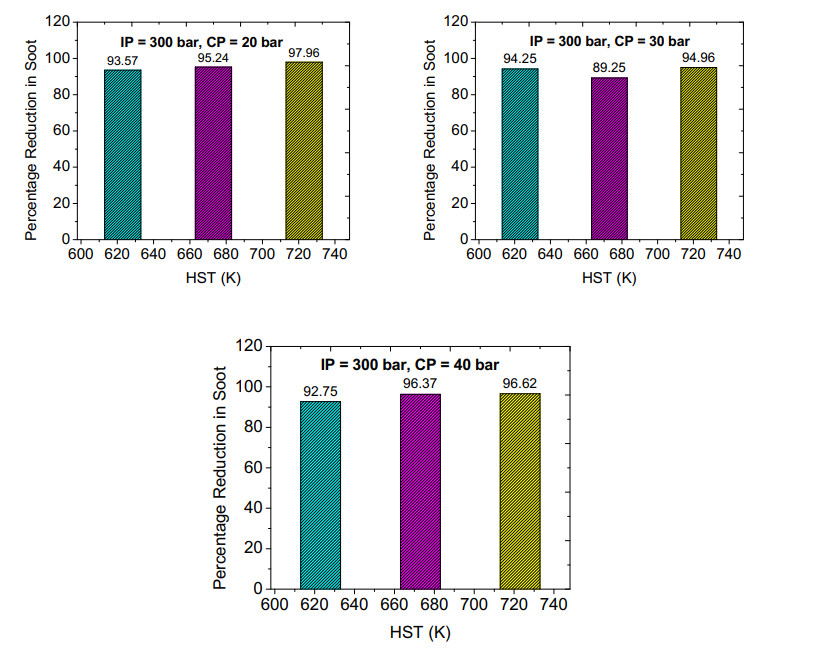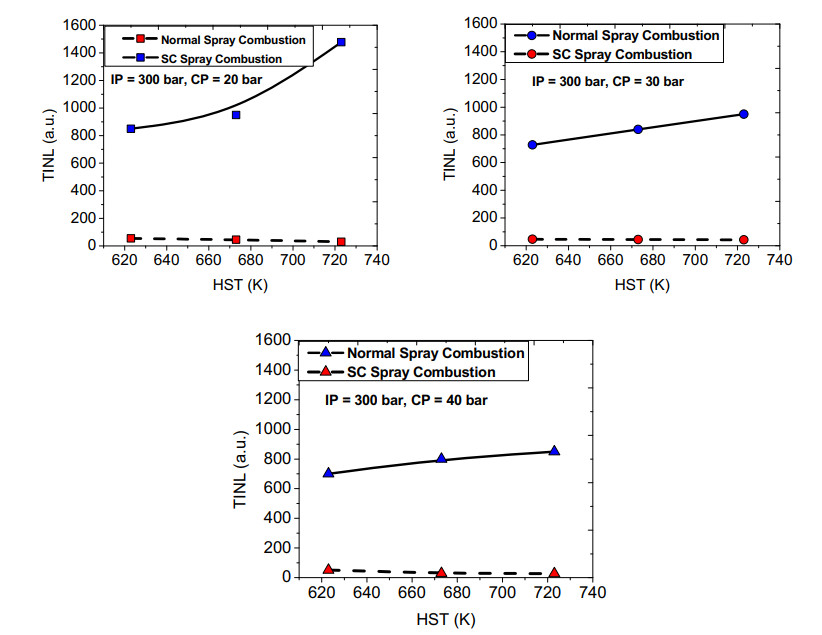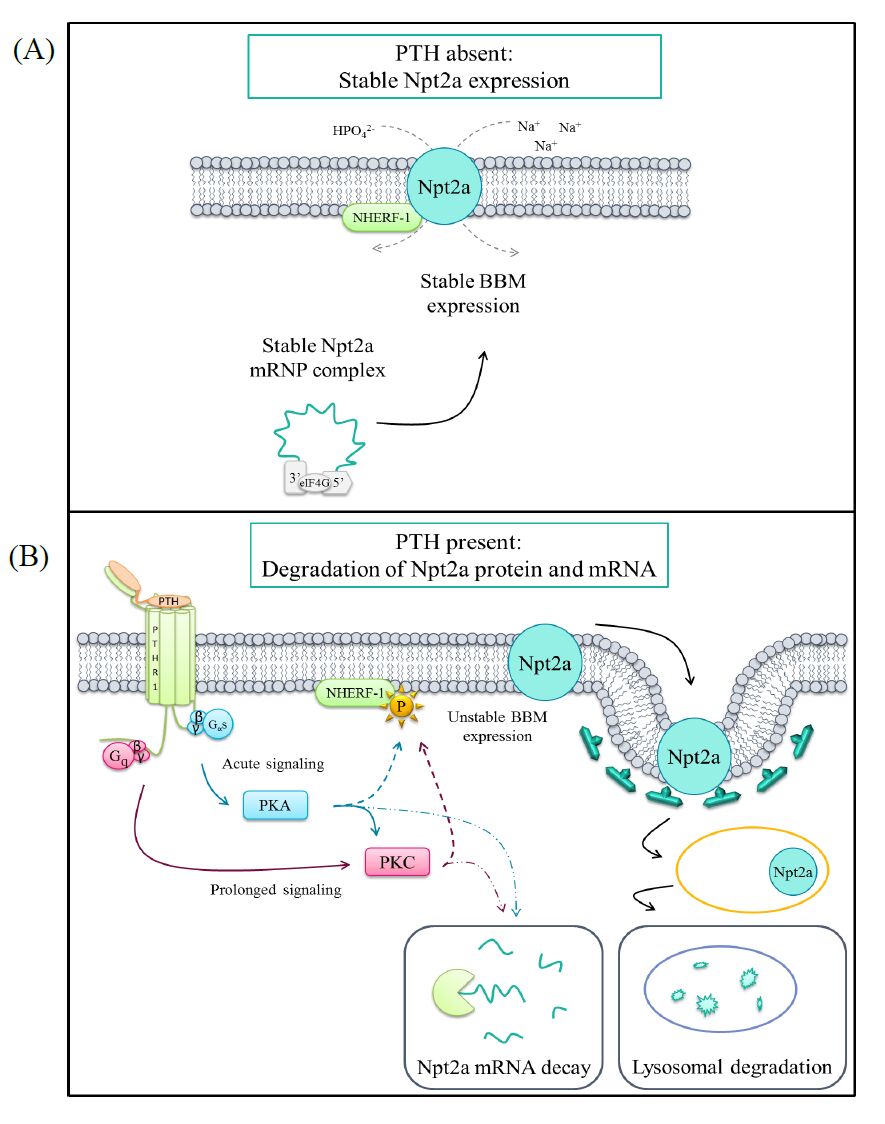1.
Introduction
In diesel engine, diesel fuel (DF) is injected as liquid in the form of sprays into the combustion chamber. After injection, atomization, vaporization and mixing of fuel vapor with air occurs inside the combustion chamber before ignition. In present scenario, spray combustion is common to diesel as well as gasoline engines. In spray combustion, diffusion flame forms because combustion reactions occur much faster than mixing of fuel with air. The fuel-lean zones are responsible for nitrogen oxides (NOx) formation and fuel-rich zones are responsible for significant soot formation (SF). Therefore incomplete fuel-air mixing leads to incomplete combustion in conventional diesel engines. The trade-off between NOx and particulate matter (PM) emissions is a very serious issue in diesel engine spray combustion [1] as shown in Figure 1. Also, soot particles alongwith other emissions from diesel engine have caused negative impacts on human health end environment [2,3]. Therefore, a breakthrough technology is required for adequate fuel delivery system associated with efficient and clean combustion.
One solution to achieve high efficiency as well as reduction in engine emissions was proposed [4,5,6]. In this new concept, fuel is injected into engine cylinder in supercritical (SC) state. In SC phase, fluid has unique thermodynamic and transport properties [7,8]. At higher temperature required for SC state, coking phenomenon occurs in fuels [9]. The formation of coke means thermal decomposition of fuel at high temperatures that result in formation of some heavy products (coke). This coke formation causes choking of injector nozzles [9]. Therefore to avoid this coke formation, some anti-coking agents were used. These anti-coking agents are also called as inert-diluents (ID) such as CO2, H2O, N2 or their mixtures (like exhaust gases). Anti-coking agents can be mixed with the DF followed by heating these mixtures to SC state before injection [6,10]. The SCF mixture upon injection into a combustion chamber quasi-instantaneously diffuses into the hot compressed air and form a single SC phase.
According to one study [11], DF can be mixed with EGR (exhaust gas recycled) either before or after the injection pumps. Alternatively, DF can be mixed with carbon dioxide before the injection pump. The content of EGR or CO2 can be controlled depending on the rpm and load of engine. Since the DF-EGR or DF-CO2 mixture is delivered as a single homogeneous SC phase to engine combustion chamber followed by a complete combustion leads to significant increase in engine efficiency and substantial reduction in emissions. The mixing of SC fuel-ID with SC air occurs nearly instantaneously due to very high molecular diffusion and combustion is homogeneous and complete. The proposed method also avoids catalytic and filtering devices for after-treatment of exhaust gases. In a similar approach [12], a mixture of DF-H2O (50%) was brought to SC conditions in a DF injection pump to achieve better air-fuel mixing. The mixture then burns in a modified diesel engine with very low NOx and smoke emissions as noticed in Figure 2. In another study [13] on SC fuel injection system, it can be seen through an optical engine fitted with a quartz window that the SC fuel delivery system does not create fuel droplets (i.e., homogeneous SC phase) as depicted in Figure 3.
Gasoline is a better choice for studying homogeneous SC spray combustion due to its many useful properties [6]. Dieseline (DL) blend composed of diesel fuel (DF2) and automotive gasoline (AG). Under homogeneous SC spray combustion study, amount of AG in DL blend can be expanded [6]. Therefore in present study, dieseline (DL50) blend is selected which contain 50% AG and 50% DF by v/v. Higher amount of AG in DF is chosen because higher amount of AG reduces estimated Tc of liquid mixture. This reduced Tc of liquid mixtures can be achieved relatively easy in the present experimental setup for producing homogeneous SC spray combustion.
Duration of combustion (DOC) and rate of heat release (ROHR) are important combustion characteristics of diesel spray combustion in conventional diesel engines [14]. ROHR concept is the basis for phenomenological model of diesel combustion engines [14]. A faster and cleaner diesel combustion process occurs due to short ignition delay and smaller DOC associated with high ROHR and also results in significant decrease in major diesel engine emissions such as PM and NOx.
Higher power densities and cylinder air pressures in modern high-speed DI diesel engines [15] caused significant increase in piston surface temperature and therefore piston’s role in ignition of sprays becomes important [16]. Modern smaller-sized engines with common-rail injection systems lead to increased spray/piston interactions and therefore results in substantial spray-impingement on piston walls [17,18,19]. In these engines combustion, efficiency and emissions significantly affected due to spray-wall impingement process [17,18,19,20]. Hence, ignition due to hot surfaces plays an important role in combustion phenomenon in small-sizes high-pressures DI diesel engines. Also, for studying basic engine combustion, constant volume chamber are frequently used among others [21,22,23,24,25,26].
As learnt from above discussion about homogeneous SC spray combustion system, it is clear that homogeneous SC spray combustion system is a promising combustion technology in terms of engine performance. It is also evident from previous studies that combustion characteristics of homogeneous SC sprays of dieseline blend (DL50) are not analyzed qualitatively as well as quantitatively. Therefore, present study investigates combustion characteristics of homogeneous SC spray combustion of DL50 blend under diesel-engine like experimental conditions in constant volume chamber. Moreover, these characteristics of homogeneous SC sprays are compared with conventional diesel sprays under similar experimental conditions. Also, comparative study of soot formation (SF) between normal diesel spray and homogeneous SC spray systems has been investigated in present work under diesel-engine like experimental conditions. Moreover in present work, effects of operating conditions such as injection pressure (IP), hot surface temperature (HST) and cylinder air pressure (CP) are investigated on DOC and SF for both injection systems. Present work will assist in understanding this new combustion system and also helps in developing homogenous SC spray injection system for efficient and clean combustion of future automotive engines.
2.
Experimental section
2.1. Experimental setup
The present setup is developed to measure combustion characteristics of homogeneous SC fuel sprays under different experimental conditions. Moreover, homogeneous SC spray combustion is analysed under very lean burning conditions (fuel-air equivalence ratio vary nearly from 0.12 to 0.065). Experimental setup and its block diagram is shown in Figures 4 and 5 respectively. The details and specifications of each component are given in [26,27].
2.2. Description of setup
Present setup has combustion chamber of cylindrical shape. Combustion chamber has fuel injector and hot surface plate (electrically heated) which are placed opposite to each other. Fuel injector having pintle nozzle (diameter of 0.15 mm) is placed infront of hot surface plate at some distance from it. Electrical heating and insulation of injector was done for producing SC sprays of DL50 blend [27]. Fuel injection pump was operated manually with the help of lever. Pressure gauge mounted on injection pump measured IP. Another pressure gauge mounted on combustion chamber measured initial CP. Photo transducer mounted on the opposite side of hot surface plate senses light luminosity during combustion of sprays. Detail of photo transducer is available in study [26]. Piezoelectric transducer is mounted on fuel line (Figure 6) and its circuit diagram is given in study [26]. Both transducers indicate their signals on different channel of scopemeter as indicated in Figure 7. Temperature indicators show HST (T1) and temperature of heated DL50 blend (T2) with the help of thermocouples. Another temperature indicator indicates initial cylinder air temperature (T3). Inlet valve for fresh compressed air and exhaust valve for exhaust gases are located at one end of combustion chamber. Compressed fresh air is supplied through multistage compressor. In case of normal diesel spray combustion study, injector is neither heated nor insulated and DF is injected at normal room temperature [26].
2.3. Experimental conditions
Experimental conditions for SC spray combustion are tabulated in Table 1. Different readings are obtained for each set of conditions, average value is calculated from four repeated readings at same condition to reduce errors in measurement and to ensure repeatability of experiments. Estimation of critical properties of DF and DL50 blend is very crucial in obtaining SC fuel spray and is discussed in the following section.
2.4. Estimation of critical properties of fuel
To enhance diesel engine performance, a new diesel combustion concept has been proposed called as SC diesel spray combustion. Implementation of this new SC diesel spray combustion concept requires accurate fuel properties in the SC region of fuel [28]. In this new concept, it is a compulsory condition that DF must be heated above its critical temperature for direct injection into engine’s combustion chamber.
2.4.1. Estimation of critical point (Tc, Pc) of DF
Since DF is composed of hundreds of hydrocarbons, therefore exact determination of critical point of DF is quite difficult. Many correlation were developed based on the availability of characteristics information of hydrocarbon mixtures such as specific gravity (SG) and boiling point (Tb) of DF. Some commonly used correlations for DF are the API method [29], covett correlation [30,31], Kesler and Lee correlation [30,32] Brule correlation [33], Riazi and Daubert correlation [30,34] Sim and Daubert correlation [30,35] Zhou correlation [30,36] and Twu correlation [37]. These correlations can be used for estimation of DF critical point. The Riazi and Daubert correlation and Zhou correlation are recommended due to their simplicity as well as accuracy in the estimation of critical point of DF [28] among others correlations. Hence, Zhou correlation has been used in present work for estimating critical point of DF.
In study [28], twenty diesel fuel surrogates (DFFs) empolyed for estimating DF chemical and physical properties. The estimated Tc of these DFFs vary significantly from 540 K to 734 K and only those of DFS#5, #17 and #19 were within the estimated Tc range of DF (717 K-745 K) [28]. Therefore, in present study DFS#5, which is n-hexadecane has been used as a representative of DF. The estimation of DF critical point using three correlations (Riazi and Daubert Correlation, Zhou correlation and Sim and Daubert correlation) are given in Table 2. Critical point of DF estimated by Zhou correlation has been considered in present study. The reason being that Tc estimated in present study by Zhou correlation i.e, 714.7 K is nearly same as estimated by Lin et al. [28] using Zhou correlation (715.58 K) for DF. The Pc estimated by Zhou correlation in present study is 19.23 bar and Pc estimated by Lin et al. [28] using Zhou correlation was 21.6 bar, which are also nearly same. Some properties of DF are given below in Table 3.
2.4.2. Estimation of critical point of DL50 blend
a) Estimation of Critical Temperature of DL50 Blend: The critical temperature of liquid mixture (TCM) is estimated with the help of Kay’s rule [40] as follows:
${T}_{CM} = {X}_{AG}\times {T}_{C, AG}+{X}_{DF2}\times {T}_{C, DF2}$
${T}_{CM} = 0.5\times 543.9+0.5\times 714.7 $
${T}_{CM} = 629.3K = 356.3\mathit{℃} $
where $ {X}_{i} $ denotes the mole fraction of respective components and $ {T}_{C, i} $ denotes the Tc of respective components in a given liquid mixture. Since DL50 is a liquid mixture of 50% DF and 50% AG by volume. Critical properties of DF (n-hexadecane) and AG (iso-octane) are given in Tables 4 and 5 respectively. Estimated value of Tc of DL50 blend using Kay’s rule is given in Table 7. Other properties of AG are given in Table 6.
b) Estimation of Critical Pressure of DL50 Blend: Thomson et al. [42] recommended the following relation for estimation of critical pressure of a liquid mixture, PCM as
where $ {R}_{M} $ is gas constant of mixture, $ {\omega }_{SRK, M} $ is acentric factor of mixture and $ {V}_{CM} $ is critical volume of the mixture.
where $ {R}_{u} $ is universal gas constant and $ {MW}_{M} $ is molecular weight of mixture. Molecular weight of mixture $ {MW}_{M} $ is given as
$ {MW}_{M} = {X}_{AG}\times {MW}_{AG}+{X}_{DF2}\times {MW}_{DF2} $
$ {MW}_{M} = 0.5\times 114.231+0.5\times 198 $
$ {MW}_{M} = 156.115kg/kmol $
$ {R}_{M} = 8.314/156.115 = 0.0533kJ/kgK $
Critical volume of mixture, $ {V}_{CM} $ is given as
where, $ {V}_{Cij} $ is given as
where $ {V}_{Ci} $ and $ {V}_{Cj} $ are critical volumes of individual component in liquid mixture. $ {X}_{i} $ and $ {X}_{j} $ are mole fractions of individual component in liquid mixture.
$ {V}_{Ci} = {V}_{AG} = 469.70{cm}^{3}/mol $ (Table 5)
$ {V}_{Cj} = {V}_{DF2} = 1034{cm}^{3}/mol $ (Table 4)
$ {V}_{Cij} = \frac{1}{8}{({469.70}^{1÷3}+{1034}^{1÷3})}^{3} = 715.16{cm}^{3}/mol $
DF may be represented by n-hexadecane because n-hexadecane is a key component of DF and its molecular weight found to be very near to the average molecular weight of DF [28]. n-hexadecane is a good surrogate for DF [9] and can be used as a reference compound for DF [4]. Also Tc of n-hexadecane (723 K) is nearly close to the Tc of DF (725.9 K). DFS like n-hexadecane is recommended in applications where critical point of DF has to be considered [28,43]. Estimated value of Pc of DL50 blend is given in Table 7.
Now, critical volume of the mixture is estimated as
$ {V}_{CM} = {0.5}^{2}\times 469.7+{0.5}^{2}\times 1034+2\times 0.5\times 0.5\times 715.16 = 733.51{cm}^{3}/mol $
$ {v}_{CM} = {V}_{CM}/{MW}_{M} = 733.51/156.115 = 0.00469{m}^{3}/kg $
Hankinson [44] recommended linear combination for calculating the acentric factor of liquid mixture. Acentric factor, ωSRK, M of the mixture is given as
$ {\omega }_{SRK, i} $ is acentric factor of individual component in liquid mixture. Acentric factor for n-hexadecane and iso-octane are given below in Tables 4 and 6 respectively.
$ {\omega }_{SRK, M} = 0.5\times 0.3045+0.5\times 0.7667 $
$ {\omega }_{SRK, M} = 0.5356 $
Critical pressure of a liquid mixture, $ {P}_{CM} $ is given as
2.5. Experimental methodology
Various experiments on DL50 blend have been carried out at different experimental conditions to study homogeneous SC spray combustion through following procedure.
2.5.1. Procedure
The various steps followed in taking reading for SC spray combustion of DL50 blend is illustrated through flowchart given in Figure 8.
2.5.2. Measurement of DOC
DOC is measured in millisecond (ms) on x-axis by noting difference between point of start and end of combustion as indicated by waveform on channel B (blue colour) shown in Figure 9. Photo transducer senses luminosity of flame due to combustion and indicates it on channel B.
2.5.3. Measurement of SF
Soot formation (SF) during the normal diesel spray and SC spray combustion is estimated at each operating condition. SF is estimated using time integrated natural luminosity (TINL) technique [19,49]. In this technique, pixel area under the curve B is calculated for estimating SF as shown in Figure 10.
2.6. Error analysis
There are two dependent (DOC and SF) and three independent variables (HST, IP and CP) in present work. Error analysis of the variables is done as follows:
2.6.1. Dependent variables
Dependent variables (DV) are measured through scopemeter. The accuracy of scopemeter at 5sec to 10μsec/div for 5 mV/div to 100V/div is ±1.5%. The percentage deviation of data from mean value is obtained at each condition in each combustion process and maximum and minimum values are shown in Tables 8 and 9.
Uncertainty in calculation of volume of combustion chamber is estimated by method illustrated in [50]. Uncertainty in calculation of volume of combustion chamber is estimated as ±0.218%.
2.6.2. Independent Variables
K-type thermocouple of accuracy ±2.2% measured HST, Tc of DL50 blend and cylinder air temperature whereas Bourdon tube pressure gauges with accuracy from ±0.25% to 1% full scale measured IP and CP.
3.
Results and discussion
3.1. Duration of combustion (combustion characteristic)
Duration of combustion includes all three stages of diesel spray combustion such as premixed combustion, mixing-controlled combustion and after-burning phase. DOC of SC fuel spray is measured through flame luminosity indicated on screen of scopemeter as shown in Figure 9. DOC is defined as duration in ms between point of start of flame formation (start of combustion) and point at which flame extinguishes (end of combustion).
3.1.1. Comparison of DOC of both combustion systems
DOC of normal diesel spray combustion at present experimental conditions is discussed in detail in study [26]. Graphs in Figures 11 and 12 illustrate variation of DOC with IP at HST = 673 K and HST = 723 K respectively and at various CP values for both combustion processes. Plots in Figure 13 and Figure 14 indicate percentage reduction in DOC with IP at HST = 673 K and HST = 723 K respectively and at various CP through histograms. In Figure 13 and Figure 14, yellow and magenta color histograms indicate highest and lowest percentage reduction in DOC respectively. It can be deduced from Figures 11 and 12 that DOC of SC spray combustion is remarkably smaller than DOC of normal diesel spray combustion at all experimental conditions. This is due to reason that SC fluids have desirable thermophysical properties that support fast and homogeneous combustion. Properties of fluids like density, volatility, diffusivity, surface tension, thermal conductivity and viscosity change in SC state significantly [7,28]. In SC spray combustion, fuel is injected into compressed cylinder air inside combustion chamber in SC state. SC fuel sprays are injected as homogeneous single-phase fluid [4] into combustion chamber and has reduced penetration lengths [6], wider spray cone angles [6], higher volatility due to more lighter/volatile components from gasoline, higher diffusivity and reduced surface tension [6]. SC fuel possess high mass transfer properties with diffusion coefficient nearly ten times higher than liquid at critical point [45]. SC state of fuel is characterized by low viscosity, high density and high mass transfer capability [47]. A homogeneous fuel-air mixture rapidly developed under SC conditions [6]. Moreover SC fuel posses high solvating capacity with other liquids [45]. Also, SC fuel spray injection is associated with relatively large spray angles and small spray penetration lengths [47] than liquid fuel spray. Also, raising fuel temperature at constant IP produces smaller spray penetration length and wider spray cone angles [48] and both these factors will improve mixture formation and mixture homogeneity considerably. Raising fuel temperature produces smaller droplets (SMD less than 7 μm) with narrow droplets size distribution (3-9 μm) and subsequently SC fuel injection has no droplets formation [47]. Raising fuel temperature results in reduced ID and DOC [47]. All these desirable changes in thermophysical properties of SC fluids and in spray geometry causes homogeneous, faster and quick mixing of SC fuel sprays with cylinder air. All these favorable properties of SC fuel sprays support faster and homogeneous fuel-air mixing as compared to heterogeneous fuel-air mixing in conventional diesel droplet spray combustion. Faster and homogeneous fuel-air mixing results in faster and homogeneous combustion of SC fuel sprays. Due to significantly faster combustion of SC fuel sprays with compressed cylinder air, DOC is greatly reduced at all operating conditions than conventional normal diesel spray combustion in present study.
Spray development affects the mixture preparation inside combustion chamber significantly and this can be explained through the non-dimensional numbers like Reynolds number, Weber number, Ohnesorge number and Knudsen number. In case of heated fuel injection system, Reynolds number is relatively large than cold fuel injection. Weber number and Ohnesorge number of heated fuel injection are an order of magnitude higher than cold fuel injection due to significantly diminished surface tension in heated fuel injection (Weber and Ohnesorge number are inversely proportional to surface tension) [48]. SC state fuel has turbulent and diffusion mixing characteristics with surrounding air. Also in case of SC fuel injection, spray core is diffused and continuous as compared to discrete surface of unheated fuel injection [48]. In case of SC spray injection than liquid fuel injection, mixture charge homogeneity considerably increased [51]. Also, it is reported [51] that SC fuel spray changes its state from SC to vapor phase on injection into combustion chamber and leads to the rapid expansion of jet. The rapid expansion of jets as well as wider spray angles and longer penetrations lengths causes more air entrainment into jet and results in enhanced fuel-air mixing and this mechanism is responsible for increased mixture homogeneity in combustion chamber. Nevertheless, SC spray injection has shorter ignition delay with spontaneous ignition at various locations inside combustion chamber and premixed combustion phase is followed by diffusion combustion with overall shorter DOC [45].
In the present study, SC fuel spray injection mainly occurs in subcritical environment (with respect to injectant’s Tc). The compressed cylinder air was at pressures (20 bar, 30 bar and 40 bar) above injectant’s Pc (17.74 bar) but at temperatures (nearly 350 ℃) lower than DL50 blend’s Tc (356 ℃). Therefore compressed cylinder air was at subcritical condition with respect to injectant’s Tc. It is reported that in case of SC fuel spray injection in subcritical conditions inside combustion chamber, surface tension effects becomes negligible on fuel-air mixing and smooth jet-gas interface with few formation of ligaments and clusters occurs at near nozzle regions [52]. However, far downstream of the injector nozzle several droplets may form and detached from the main body of jet. This occurs due to heat transfer from the jet to surrounding medium and increase in surface tension at lower ambient charge temperature. However, when fuel is injected in high temperature and pressure chamber conditions (typical diesel engine conditions at TDC) exceeding the critical point of injected fuel there were no evidences of ligaments and droplets formation due to absence of surface tension [53].
It can be noticed in Figures 13 and 14 that at all experimental conditions, percentage reduction in DOC in SC spray combustion with respect to normal diesel spray combustion is above 35%. Faster and homogeneous combustion of SC fuel sprays produces dramatically lowered exhaust emissions mainly PM and NOx [12,45,51,54]. Therefore, SC spray injection and combustion system is a clean and efficient combustion technology for automotive engines [55]. This combustion technology will significantly reduce harmful exhaust emissions in the environment.
3.1.2. IP, HST and CP Effect on DOC
As discussed above, in case of SC spray injection, impingement of SC sprays on hot surface sufficiently reduced due to lesser spray tip penetration lengths and wider cone angles of SC fuel sprays [6] and these factors may causes hot air combustion of SC fuel sprays rather than hot surface ignition. However, normal (non-supercritical) spray combustion occurs due to hot surface ignition of impinging diesel sprays. Since ID of SC fuel sprays [56] is very small (nearly 2-3 ms) as compared to ID of normal diesel sprays (nearly 6-24 ms) therefore corresponding premixed combustion phase after completion of ID period in case of SC fuel sprays will be significantly smaller. Therefore, mixing-controlled combustion phase is observed to dominate SC spray combustion in present work. Mixing-controlled combustion nature of SC sprays combustion is also confirmed by the fact that SC spray combustion process is significantly affected by IP rather than CP as pointed in Figures 11 and 12. Since, hot air combustion is also significantly affected by IP [14,57]. Higher IP enhances homogeneous mixing of fuel-air and consequently reduces mixing-controlled combustion or diffusing burning phase and ultimately DOC reduces as shown in Figures 11 and 12 for SC sprays. With increase in IP of SC sprays, DOC continuously decreases and it is minimum at 300 bar IP at both values of HST (673 K and 723 K). Also, it is found from Figures 13 and 14 that there is a dip in percentage reduction in DOC at 200 bar IP. This may be due to the fact that IP effect on DOC mitigates in normal diesel spray combustion as IP increases [26]. However, in case of SC spray combustion, effect of IP on DOC becomes more stronger at higher IP and therefore combustion is observed to be faster at 300 bar IP. Higher IP of the fuel generates faster combustion rates [58,59] and faster combustion rate results in rapid combustion which have short DOC of fuel jets [45,60]. Higher IP leads to larger penetration of fuel jet and hence better mixing of fuel and air inside combustion chamber. Moreover, spray/jet structure or shape is not affected by the quantity of fuel injected into combustion chamber [6]. Moreover, phenomenon occurring in diesel injector leads to the development of increased turbulence near-nozzle regions, which causes disintegration of fuel jets and increased spray cone angles [61]. All above factors resulted in nearly complete and faster combustion of the fuel sprays inside combustion chamber at higher IP.
Also, it can be noted that there is a marginal effect of CP on the DOC for SC fuel sprays as shown in Figure 11 and Figure 12. The same effect can be observed in Figure 13 and Figure 14 by noting the difference in values of percentage reduction in DOC with increase in CP of air at both HST values. Since, CP of air mainly affects the ID and has minor effect on fuel-air mixing and hence on mixing-controlled combustion phase [14], therefore DOC is insignificantly affected by CP of air inside combustion chamber. Also, it can be noticed from Figure 13 and Figure 14 that percentage reduction in DOC slightly decreases with increase in CP. Percentage reduction in DOC is high at lower CP (20 bar) and low at higher CP (40 bar) for both temperatures (HST = 673 and HST = 723 K).
It is observed from Figures 11 and 12 or Figures 13 and 14 that DOC of SC fuel sprays is also affected by HST. It is found that DOC of SC fuel sprays insignificantly reduced with increase in HST from 673 K to 723 K at various CP values. However, effect of increase in HST from 673 K to 723 K on DOC of normal diesel sprays is significant at all CP values [26]. The insignificant effect of increasing HST on DOC of SC fuel spray combustion may due to the reason that SC fuel spray combustion occurs in hot compressed air inside combustion chamber and moreover because of reduced penetration lengths and wider cone or spray angles of SC fuel sprays. Hence, there is no impingement of SC fuel sprays on hot surface unlike that of normal diesel spray (impinging on hot surface) and consequently combustion of SC fuel sprays is less affected by HST. However, small decrease in DOC of SC fuel sprays with increase in HST is attributed to the increase in compressed cylinder air temperature with increase in HST. Any increase in HST causes increase in compressed cylinder air temperature. It is interesting to note that at typical normal operating conditions of small bore high speed DI diesel engine (high IP, CP and HST), reduction in DOC is found to be lowest.
3.2. Soot formation characteristics
The combustion process can also be characterized by the flame or natural luminosity [17]. The flame luminosity includes two phenomena i.e., soot incandescence and chemiluminescence. The soot incandescence is the major source of flame luminosity [17,49]. The intensity of chemiluminescence is much weaker than the intensity of soot incandescence [62]. Flame (natural) luminosity indicates soot emissions because soot incandescence depends on soot concentration and temperature [62] and soot incandescence is main part of flame luminosity. Flame or natural luminosity is the indicator of soot formation [49].
Flame or natural luminosity is measured in terms of spatially integrated flame luminosity (SINL). SINL value is calculated by integrating pixel values over entire flame image. SINL is a combination of the soot concentration and temperature [19,64]. Therefore higher values of SINL indicate higher formation of soot particles [19,65]. To better quantify the flame luminosity characteristics of entire spray combustion process, time integrated natural luminosity (TINL) is employed [49]. The TINL is an indicator of soot formation (SF) during whole combustion duration [19,49].
TINL values are evaluated through the integration of SINL with time [49]. In present study, TINL value is calculated as area under the entire flame curve B as shown in Figure 10. The flame luminosity curve B is obtained as a function of time over the complete combustion process or DOC. Therefore area under the curve B indicates the level of SF during whole combustion process and it is denoted as TINL. TINL values are indicated in auxiliary units (a.u.).
3.2.1. Soot formation in normal diesel spray combustion system
It can be seen in Figure 16 that TINL values are high at higher HST (723 K) as compared to lower HST (623 K) at all CP. The reason may be that as HST increases the temperature gradients near the hot surface decrease and ID shortens and this leads to insufficient mixing of fuel-air and fuel-rich combustion products. Therefore high SF (higher TINL value) occurs at higher HST [17]. It can also be seen from Figure 16 that TINL values are lower at higher CP (40 bar) as compared to lower CP (20 bar) at all values of HST. In other words, TINL values decrease with increase in CP from 20 bar to 40 bar. In the condition of lower CP, wall temperature has a greater influence on flame luminosity as indicated by TINL values in Figure 16. This is because when the CP is lower, ID will be longer, fuel-air mixing during ID will be proper and HST dominates the combustion process [17].
In the condition of higher CP, ID will be shorter and fuel-air mixing during ID will be insufficient, the flame will be very close to the hot surface and therefore has difficulty of air entrainment [17,66] and also has the probability of liquid-wetting of hot surface. Therefore because of these reasons combustion near the hot surface will be rich combustion and has higher SF [17,67] and these reasons weaken the effect of HST on TINL or flame luminosity at higher CP. Feng et al. [17] also reported similar trends of flame luminosity variation with heated wall temperatures and cylinder pressures for higher IP (600 bar to 1600 bar) in CVCC. SF (flame luminosity) significantly increases as a result of impinging sprays in comparison to free sprays as reported in literature [68,69,70].
3.2.2. Soot formation in SC spray combustion system
In present study on SC fuel spray combustion, TINL values are calculated for 300 bar IP case only for both combustion systems to quantify and compare SF levels in these two combustion processes under similar operating conditions. Graphs in Figure 15 show the variation of percentage reduction in SF in SC fuel sprays than normal diesel sprays with HST at various CP values and at constant IP of 300 bar. Increase in percentage reduction in SF with increase in HST is presented by change of color of bars (yellow histograms indicate highest percentage reduction in soot). It can be noticed from Figure 15 that at a given IP and at all CP and HST values, SF levels in case of SC spray combustion are greatly reduced to much lower values than SF levels in normal diesel spray combustion. It is evident from these plots in Figure 15 that SF levels or TINL values are reduced atleast by nearly 90% in SC spray combustion than normal diesel droplet spray combustion. The similar reduction in SF is also reported by some researchers in case of SC spray injection and combustion process [12,48,51,54]. Heated fuel injection resulted in reduce soot emissions [47]. Since SF generally depends on the combustion of lower air-fuel ratios mixtures. The lower local air-fuel ratios or rich mixtures mainly produced due to the maldistribution of fuel in the surrounding air, wall wetting or impingement of fuel sprays and fuel droplets [51]. Injection of fuel as SC fuel into compressed air appears to have reduced these causes of SF in present study and therefore results in significant reduction in SF in SC fuel spray combustion process. Also, since SC fuel injection contains no liquid fuel droplets and hence shows significant decrease in SF [45].
Simultaneous reduction of both NOx and PM is reported when SC fuel spray combustion occurred in engines or in other combustors [12,54]. In present study, only SF is quantified and compared with the help of TINL values but on the basis of previous studies [12,54,71] it can be state that simultaneous reduction of NOx will also occurred in SC spray combustion of DL50 blend. NOx formation will be significantly lower in SC spray combustion since SC spray combustion occurs at lower combustion temperature than normal diesel droplet spray combustion’s temperature [71,72]. Temperature spikes and fuel rich regions are absent in homogeneous single-phase SC spray combustion [4] unlike that of normal diesel spray combustion and hence significant reduction of both major diesel engine emissions (NOx and soot) and improved efficiency is ensured in this new combustion technology.
SC spray combustion takes place in larger volume than only around fuel spray envelope as well as combustion occurs at lower temperature and hence avoids NOx formation [71,72]. Moreover, simultaneous reduction of both NOx and soot may due to the enhanced premixing associated with the SC injection of fuel into combustion chamber [73]. SC fuel spray combustion not only produces lower levels of NOx and soot but also generates smaller levels of other gaseous emissions such as CO, HC and CO2 as compared to conventional diesel droplet spray combustion process [4,12,45,51,74]. However in conventional engines, EGR systems besides other techniques significantly affected combustion and emissions formation [75]. In a study [4], SC fuel spray combustion produced reduced harmful emissions like PM, NOx, SOx, CO, aldehydes and polyaromatic hydrocarbons (PAHs) alongwith improved efficiency.
Plots in Figure 16 show the comparison of SF levels in both combustion systems at fixed IP of 300 bar and at different CP and HST values. TINL values are calculated at each operating condition for both combustion systems and plotted against HST to quantify the SF levels under similar operating conditions in CVCC. Each plot of Figure 15 shows substantial reduction in SF level for SC spray combustion than normal diesel spray combustion. The reasons for dramatic reduction in SF in SC spray combustion are given in previous paragraphs. It can also be observed in Figure 16 that in case of SC spray combustion, SF level slightly reduces with the increase in CP. Moreover, it can be observed in Figure 16 that with increase in HST, SF level decreases gradually in SC spray combustion. The decrease in SF with increase in HST may due to the reason that increase in HST results in corresponding increase in temperature of cylinder air and therefore oxidation of fuel-rich regions enhances with rising cylinder air temperature. The reduction in SF with increase in CP may be due to the fact that increasing CP increases density of cylinder air and this causes enhancement in fuel-air mixing process as well as mixture becomes more homogeneous and also avoids local fuel-rich mixtures regions, similar findings regarding soot formation are reported in [76]. All these factors reduce SF at higher CP.
4.
Conclusions
Combustion and soot formation characteristics of homogeneous SC sprays in CVCC are studied under diesel engine-like experimental conditions. It is found that DOC of SC sprays are substantially lower than DOC of normal diesel sprays (percentage reduction in DOC is more than 35% in SC spray combustion than normal diesel spray combustion) under all present conditions. Smaller DOC means homogeneous, single-phase and faster combustion of SC sprays due to more homogeneous and enhanced mixing of SC sprays with cylinder air. Percentage reduction in DOC of SC sprays is found to be highest (>80%) at higher IP of 30 MPa. This means that even more faster combustion of SC sprays than normal diesel sprays occurs at higher IP. SC spray combustion appears to be a hot-air combustion. Also, it has been observed that percentage reduction in soot formation in SC spray combustion than normal diesel spray combustion is more than 90% at all conditions. At normal diesel engine operating condition, percentage reduction in DOC and soot formation of nearly 82% and 96% respectively are achieved. In SC spray combustion, soot formation reduced slightly with increase in CP and HST. On the basis of present work, it is felt that the new concept of homogenous SC spray injection and combustion can prove out to be a promising technology (cleaner and efficient) for improving engine performance and can be recommended for future generation automotive engines.
Although there are some limitations of present study such as use of lower injection pressures, higher concentrations of gasoline in DF and investigation of soot formation only. Therefore, as a part of future work, lower concentrations of gasoline (<50%) in DF and higher injection pressures above 30 MPa can be explored and study of other exhaust emissions such as hydrocarbons, oxides of nitrogen, carbon monoxides may be investigated.
Acknowledgements
This work is supported by Technical Education Quality Improvement Program-III, MHRD, Govt. of India.
Conflict of interest
The authors declare that they have no known competing financial interests or personal relationships that could have appeared to influence the work reported in this paper.
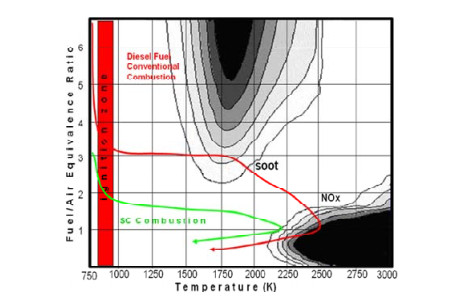









 DownLoad:
DownLoad:
